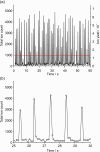Rapid and Sensitive Chemical Analysis of Individual Picolitre Droplets by Mass Spectrometry
- PMID: 39719369
- PMCID: PMC11740182
- DOI: 10.1021/acs.analchem.4c05458
Rapid and Sensitive Chemical Analysis of Individual Picolitre Droplets by Mass Spectrometry
Abstract
Aerosol droplets are unique microcompartments containing microscopic amounts of material and exhibiting surprising chemical reactivity. Although a diverse set of tools exists to characterize the chemical composition of individual submicron particles in air, comparatively fewer approaches can chemically analyze individual, airborne picolitre droplets. We describe a novel approach for mass spectrometric analysis of individual aqueous picolitre droplets (∼2-180 pL volume) containing down to ∼1 pg analyte mass per droplet. Individual droplets are generated using a microdroplet dispenser, imparted a small amount of net charge, and guided to the inlet of a high-resolution mass spectrometer using a linear quadrupole-electrodynamic balance. Analyte molecules within the aqueous droplet are ionized using droplet assisted ionization, where droplet breakup within the mass spectrometer inlet leads to generation of molecular ions. This single droplet mass spectrometry approach is demonstrated for small molecules and proteins. The approach generates clean mass spectra, permits timing of droplet delivery for chemical analysis, and, by avoiding a separate ionization stage, avoids potential artifacts arising from current electrospray-based approaches for picolitre droplet analysis. It is anticipated this approach will permit exploration of the factors governing accelerated chemical reactions in aerosol droplets and will be suitable for sensitive analysis of particularly precious samples in different application domains.
Conflict of interest statement
The authors declare no competing financial interest.
Figures






References
-
- Yan X. Emerging Microdroplet Chemistry for Synthesis and Analysis. Int. J. Mass Spectrom. 2021, 468, 116639.10.1016/j.ijms.2021.116639. - DOI
LinkOut - more resources
Full Text Sources

